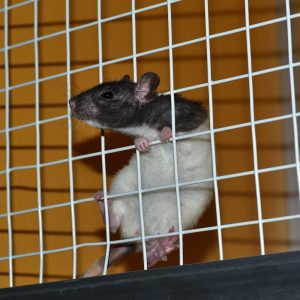Contents

Pet rats are a joy to those who choose to share their lives with them. A lot of this joy comes from rat personalities and behaviors. Who wouldn’t get a kick out of seeing pet rats explore the environment, check out a new toy, or snuggle into your shoulder? Pet rats share some of the behaviors you see in other, more common pets, but a few are unique to rats.
Some words to describe most pet rats include: sociable, curious, and intelligent. All of these come into play for explaining why rats make such great companions. They enjoy being with their people, are curious about their people, and have the smarts to interact, explore, entertain, and be entertained. But these wonderful traits can also lead them into trouble. What behaviors can you expect if you share your home with pet rats?
1. Vocalizations
Rats are generally quiet pets, at least to human ears. They usually vocalize in a range above normal human hearing. But even though we miss out on most of a rat’s “talk,” we do hear some of their vocalizations. Gentle chirps or clucks, grinding, squeaks, and hissing are a few of the vocalizations you will hear. The context usually gives you a hint about whether your rat is happy, content, upset, scared, or in pain. Often, higher-pitched, faster-tempo noises indicate a rat is disturbed.
2. Play Fighting
Rats are sociable and do best living in same-sex pairs or groups, but this doesn’t rule out play fighting. (Note: Introductions between rats should be done in neutral territory with treats. Always supervise newly introduced rats when together until you are certain they are getting along.) Rats seem to enjoy the occasional tussle with a cagemate: chasing, pinning, and some vocalizations are normal. If you notice raised fur or hissing occurs, pay attention, this could get serious. If it seems like one rat is constantly being bullied (kept from food or drink, not allowed to rest), you might need to intervene. If blood is ever drawn, separate the rats. You’ll likely need to keep the rats in separate habitats.
3. Gnawing
Rats are members of the rodent family, and rodents are known for chewing. And they’ll chew anything, not just food. The frequent chewing helps wear down rats’ constantly growing incisors. It’s a need they must satisfy, so be prepared by offering rat-safe chew toys in the habitat, rat-proofing any rooms you let them access, and supervising them whenever they’re enjoying free-roam time outside the cage. Furniture, clothing, drapes, power cords, and more could feel the gnaw of your rats’ teeth if you don’t keep these items out of reach.
4. Burrowing
Another trait of rodents is burrowing into bedding. Pet rats enjoy digging. It’s another instinctive need they must satisfy. Help your rat buddy out by providing rat-safe bedding for burrowing and a rat-safe dig box filled with clean dirt, play sand, biodegradable packing peanuts, or other rat-safe material.
5. Nighttime Antics
Rats are mostly nocturnal. They can adjust their schedule somewhat to yours, but their most active time is dusk through dawn. This means keeping them in your bedroom might make for some noisy nights.
6. Climbing

Pet rats need exercise, and one great way to encourage this is with rat-safe ropes, ladders, and climbing toys. Most rats enjoy climbing. A rat-specific exercise wheel is another great option for exercise. The flip side is that because rats enjoy climbing, rat-proofing might be more of a challenge. So don’t be surprised if you find your rat climbing a mesh wall or scaling your drapes.
7. Investigating
Vision is not their strongest sense, so rats mainly explore by smell and touch. All that sniffing you see? That’s your rat checking things out. You might also notice your rat explores new areas by hugging the walls or some other “path” in the environment. This is normal for a prey animal, because they don’t want to be exposed out in the open. It can also help them navigate.
8. Licking
The reasons your rat licks you or other rats vary. It could be a sign of affection. It could be your rat is in grooming mode. It could be that your rat tastes something delicious. It could be just another way to explore the world. Whatever the reason, it’s perfectly normal (unless it becomes obsessive).
9. Grooming
Rats are normally fastidiously clean animals. They groom themselves numerous times throughout the day. This usually starts with the front paws rubbing the face, then moving down the body all the way to the end of the tail. There’s usually no need to worry about giving a rat a bath; rats keep themselves quite clean. It’s actually one sign of possible illness if you notice a rat stops grooming or has an unkempt coat. (Note: You will need to help out your rat with nail trimming.)
10. Biting
Rats have teeth, so the possibility of biting must be mentioned. When startled or in pain, a rat might bite. Pet rats are among the most easygoing of rodents, though, so your chance of being bitten is minimal as long as you don’t startle them or pick them up when you suspect they’re in pain.
11. Boggling
Boggling refers to when a rat’s eyes seem to move quickly in and out of the socket. The eyes can get quite large. This happens when the rat is grinding the front incisors (bruxing), and usually when a rat is content.
12. Bruxing
Bruxing refers to clenching or grinding the teeth. In pet rats, this is a noise made when they grind their incisors together. It’s a normal sound and most often heard when a rat is relaxed, but it can also occur when a rat is stressed. Take your cues about how your rat might be feeling from the circumstances. Intense bruxing can also cause eye boggling.
13. Coprophagia
In the unbelievable-but-true department, rats are known to eat their own feces or those of other rats. They might also lick urine. Although it sounds gross, it’s normal. You might never see it happen, but don’t be concerned if you do.
14. Male Vs. Female Personalities
You might hear anecdotal stories about behavior differences between male and female rats. Some people believe male rats move slower, cuddle more, and are more easygoing. Females are known for being playful, energetic, and less likely to cuddle. Is this true? You will have to be the judge. All rats are individuals, so it’s best to judge them as individuals.
15. Scent Marking
Many animals do scent marking. For some, this just means rubbing a gland against what they wish to mark. Dogs on a walk do “tinkle mail” to communicate to other dogs in the neighborhood. For pet rats, scent marking can vary from rubbing their face against something to peeing on it. Males seem especially prone to scent marking.
16. Signs of Trouble
Rats are prey animals and generally try to hide when they’re feeling sick or in pain. This makes it extra important for you to know the normal behavior of your rat pal. When you notice your rat doing something abnormal, consider whether it could be a sign of illness or pain. Some common behaviors associated with rat health problems include a hunched posture, staring, stumbling, head tilt, failure to groom, sneezing, and wheezing. This is only a partial list.




